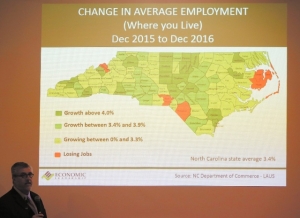Jobs shrink in rural areas
By Steve Herring
Published in News on August 25, 2017 5:50 AM

News-Argus/CASEY MOZINGO
Keynote speaker Ted Abernathy shows Wayne County saw between a 0 and 3.3 percent growth in employment in 2016.
An informal poll of area business, civic and government leaders Tuesday gave the state and Wayne County's economy a smattering of B's and C's and even a D or two, but no A's or F's.
The urban-rural divide and a job skills gap, two frequent discussions when local leaders talk about the economy, played into comments by Ted Abernathy, managing partner at Economic Leadership.
Abernathy was the keynote speaker for the Wayne County Chamber of Commerce's Economic Hot Topic luncheon at the Goldsboro Event Center.
North Carolina is about 2.3 percent below the expected job growth, he said.
A lot of the state's growth over the past five years is because of people moving in, Abernathy said.
"So you have to generate more jobs as people move in," he said. "We are one of the top five fastest-growing states in the country. So you see the South has really not made up all of the jobs that we lost."
Over the past 12 months the state's growth has been about 1.5 percent, pretty much on par with the national rate of 1.6 percent, he said.
"If you want to know what is going to happen in North Carolina, watch the national data," Abernathy said.
The rate of people moving in also slowed, so the unemployment rate has remained about the same, he said.
But the growth is uneven among men and women, and between those with college degrees and high school diplomas, he said.
It is uneven for places, too, he said.
From December 2015 to December 2016 there were very few counties in the state that did not see their employment grow during that time. Wayne County's growth was in the 1 to 3 percent range, he said.
"You are not one of the fastest-growing counties, but solidly growing," Abernathy said.
Employment is about the people who live in your community, while job numbers are about Wayne County employers, Abernathy said.
Job numbers flattened out, he said.
"You're not actually very deep below zero," he said. "You are just a smidge below (0.2 percent). There are lots more numbers of people that are working, but have to commute outside the region or their home county to work."
That is particularly true in the northeastern part of the state where people are driving up into Virginia to work or down into Pitt County, he said.
However, even being in a city or metro area does not mean you will be safe, Abernathy said.
Top factors in growth continue to be the availability of a skilled labor force, access to highways and labor cost. Joining that list are land and building availability, he said.
Since the recession of 2009, metropolitan regions have grown much faster than non-metro regions, he said.
Since the 1950s, 57 percent of the U.S. population now lives in cities of one million or more. By mid-century that is expected to reach 80 percent.
Children and college graduates are overwhelmingly moving to cities, and even grandparents are moving to larger cites to be with their grandchildren, Abernathy said.
The good news for Wayne County is that it experienced some small growth, he said.
The bad news is that surrounding populations are shrinking.
That makes it more difficult from an economic standpoint, he said.
Nearly half of the state's counties are losing populations. Even those not losing population are losing working age populations, Abernathy said.
Projections over the next 20 years show counties losing even more working age populations -- a story being repeated nationwide, he said.
For Wayne County the question is how to make the numbers go up and by age brackets, Abernathy said.
"How do you attract more people under the age of 50 who want to bring their families and come in and be a part of your workforce because that is the only way you are going to drive your economic growth," he said.
Nationwide, one half of the population lives in just 142 counties, which amounts to one half of the voters and two-thirds of the economy, Abernathy said. The other half lives in 3,100 counties.
In the North Carolina there are six urban counties, 14 regional or suburban and the rest are rural.
"If you look at the growth, over the last five years, the six urban areas have 45 percent of the jobs," he said. "But in the last five years they have attracted 66 percent of the new jobs. The suburbans -- the Durhams of the world -- the other regional centers, Pitt is in there I think had 20 percent.
"The rural counties, the other 80 counties, had 35 percent of the jobs and only 11 percent of the growth."
Most of the growth in rural counties is in leisure and hospitality which is eating and drinking, he said.
Those jobs are important for the community because they bring outside money in, he said.
But the average wage is about $19,000 for that sector compared to about $80,000 for urban sector jobs, Abernathy said.
The urban-rural divide will continue to be an issue, he said.
"Part of what needs to be done, we need to target different types of industries with our marketing money to help less urbanized counties become stronger with building new sites and infrastructure," he said. "There are investments that can be made. Without those investments they won't get the people."
Counties also have to deal with a skills gap.
College is not for everyone, and education will one day look different than it does now he said.
For example 39 percent of jobs require just a high school diploma or equivalent. Another 26 percent require less, he said.
